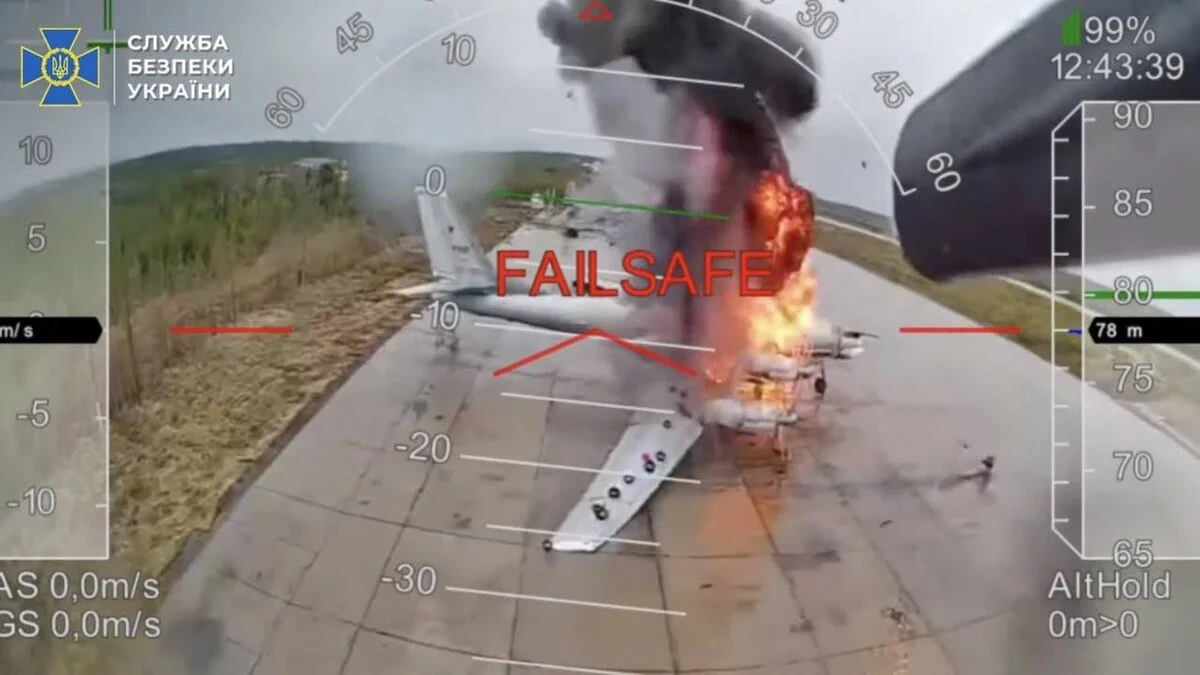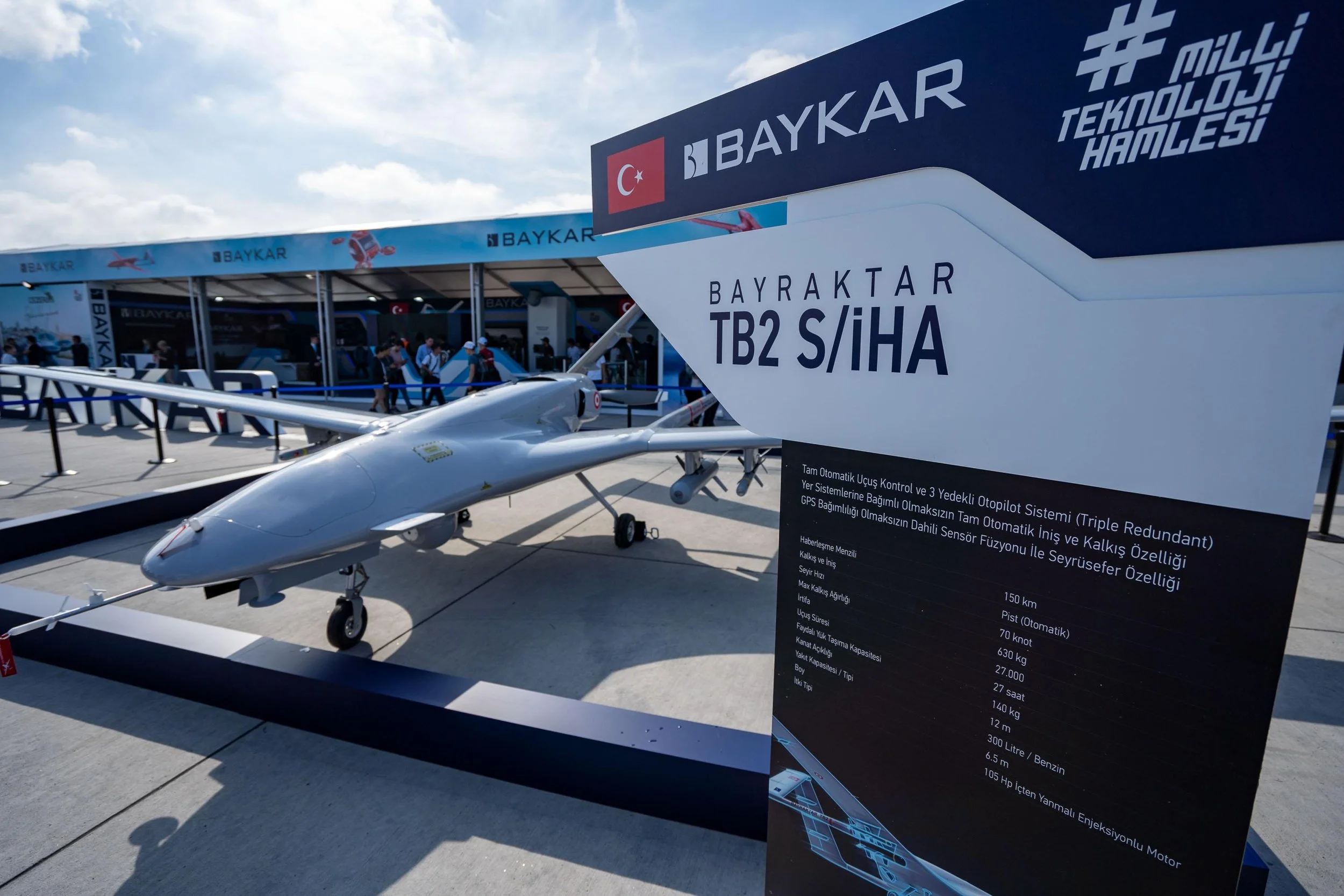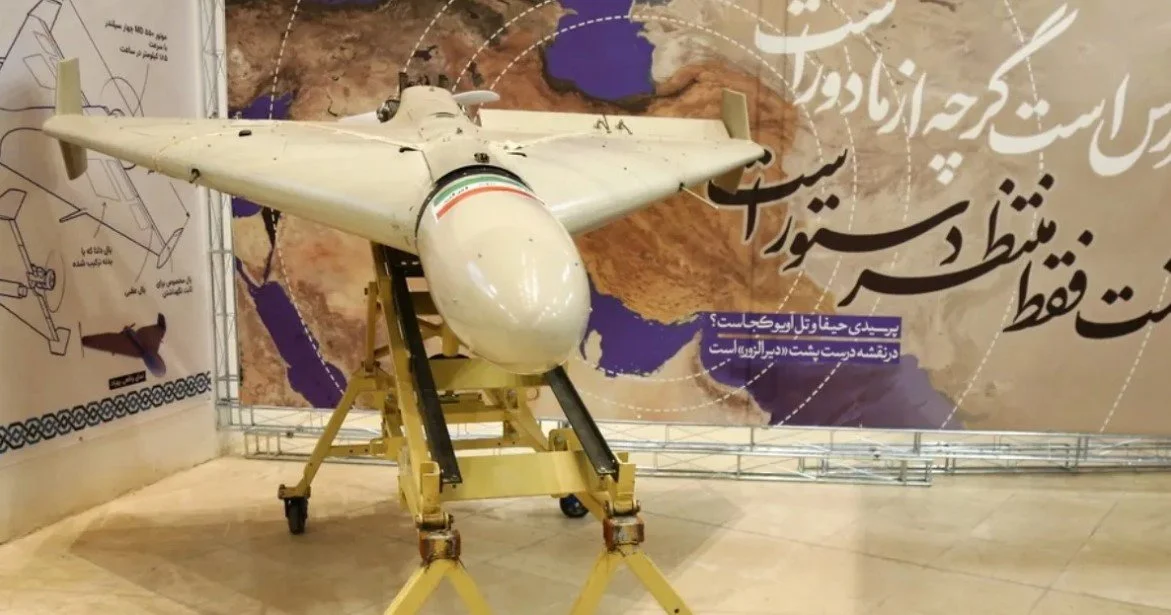The Rise of Drones in Global Conflict
October 13, 2025 - Written by Elle McCallum
Introduction
The past year has been a landmark year for drone warfare, with the technology adopted by an array of actors throughout the world, with ramifications for military strategy, policy, and the nature of conflict itself. Drones have dominated major conflicts on multiple battlefields, marking a revolutionary transformation in warfare.
Both expendable and adaptable, with minimal human cost due to remote operation, drone warfare offers a low-cost and high-impact solution for those seeking high-impact damage to infrastructure and enemies with minimal human cost. Considering its growing accessibility and positive media coverage, drone usage has become the norm in conflict, as an array of state and non-state actors turn to drone warfare to hone their influence and strength, harnessing the strategic advantage of remote warfare. The result of their unique profile and widespread adoption means drone production has exploded, with the number of companies manufacturing drones for international warfare expanding from 6 in 2022 to over 200 in 2024.
The prevalence of drone use and development for modern warfare is unlikely to end anytime soon. Central actors across the international system have now adapted their plans for the future of conflict to accommodate drones as a fixed and permanent feature of combat. The increased utilisation of drones marks the trend of robotic advancement and increased precision of military machinery, which has been firmly adopted by the military industrial complex.
The following review highlights key events, dynamics, and developments across the international system that reflect how the increased use of drones can affect warfare and global stability.
Drone Warfare
Drones, including unmanned aerial vehicles (UAVs), can be armed or unarmed, serving a range of purposes in combat, including intelligence, surveillance, target acquisition, and reconnaissance, executing attacks on personnel and infrastructure, and continuous observation. UAVs are remotely piloted, with ground crews operating from up to thousands of miles away in different states to their targets. Ground crews typically consist of a pilot, sensor operator and mission intelligence coordinator, working for extended periods requiring intense attention to detail and exposure to combat visuals on computer screens.
Both academic and military sources have acknowledged that the use of drones in conflict strategy is the next necessary evolution in strategic warfare. Drone strikes seek to minimise major loss of life and property through remote engagement in conflict, offering tactical advantages. Operators are no longer limited by the human constraints of fatigue, injury or illness and can survey a target for prolonged periods from a place of safety. The precision provided by drones is unparalleled compared to that of ground troops, and drones are more financially advantageous than the acquisition, maintenance and operation of a manned aircraft doing the same surveillance.
However, many concerns have been raised. Amidst potential unintended civilian collateral damage and a significant impact on remote operator mental health, the accessibility of drones to non-state actors, given their low cost and accessibility, could cause a rise in conflict. Who is in control of the drones being used in conflict, and what is the aim of non-state actors utilising drones, remains unclear.
Moreover, the pairing of drones with artificial intelligence (AI) tools pushes the boundaries of military technological innovation. Removing human executive control in military operations by implementing purely algorithmic control of drone operations has troubling implications, and this pairing of remotely operated drones and AI tech has been dubbed “digital dehumanisation". In light of such concerns, governments and international bodies are calling for stronger regulations on usage amid fast-paced developments in the combination of drone implementation on battlefields and AI. These new battlefield norms of remote-controlled drones and AI are desperately in need of international oversight that understands and regulates this new warfare.
Levelling the Battlefield
One of the greatest strategic advantages provided by drones in conflict is their ability to empower smaller players in conflicts to engage in conflict against larger players with more funding and ground forces. Ukraine serves as a textbook example of how drones can provide leverage in asymmetric conflict. The state has steadfastly maintained a status quo against a far more powerful adversary, Russia, by actively developing drone technology and utilising drones. The accessibility and affordability of drones, paired with their effectiveness in combat, allow smaller actors to defend themselves against aggression from traditionally dominant actors, effectively levelling the battlefield. Smaller actor capacity for combat is amplified, as recently seen in Ukrainian drone operations.
Operation Spiderweb unfurled on June 1, 2025, and saw 117 Ukrainian quadcopters strike Russian air bases. The covert operation took over one year, six months and nine days to orchestrate, entailing the smuggling of quadcopter drones through commercial vehicles before launching the attack on Russian airbases across the state. Quadcopters are a relatively simple drone type, but have been proven highly effective in causing disruption and destruction in asymmetric conflict. The attack was believed to have deployed rigged versions of the commercially available quadcopter drones. The damage inflicted by a relatively low-level technology was staggering - Ukrainian quadcopters successfully hit 41 Russian strategic bombers, destroying at minimum 13, and causing damages of up to USD $7 billion - but only costing a fraction to orchestrate and execute.
More recently, Ukrainian drone strikes targeting Sochi and Leningrad on September 9 and 12 damaged Russian oil terminals and crude ports, exacerbating the Russian fuel crisis and ongoing inflation. Transnet, the Russian state-controlled oil pipeline company that handles over 80% of Russian crude oil output, has since restricted oil storage and warned producers that it may have to reduce its output following damage from the drone strikes. Ukrainian President Volodymyr Zelensky described the strikes on Russian energy assets as "the sanctions that work the fastest." Russian oil facilities have been noted as targets for Ukrainian drone attacks due to their role in providing profits to fuel the war and the state's revenue as a whole.
Considering the asymmetry between Ukrainian and Russian military capabilities, the impact of Ukrainian drone operations highlights the potential of low-cost commercial drones to provide smaller states with an opportunity to strike back, through damaging enemy infrastructure and resources. The combination of Operation Spiderweb’s publicity with the commercial availability of the technology utilised may create appeal for replication amongst non-state actors. Insurgent groups could easily utilise modified systems, as done in Operation Spiderweb, to act outside a state-sanctioned framework, regardless of motive and target.
Drone striking a Tu-95 at Russia’s Olenya airbase during Operation Spiderweb.
Geopolitical Influence
Besides empowering actors facing asymmetry in conflict, the increased use of drones has created opportunities for supplying actors to exert influence within the international system. Key manufacturing states could cultivate ties with previously inaccessible or uninterested actors and stakeholders. Türkiye has risen as a key supplier of drones in today’s international system, expanding its geopolitical reach and influence.
Turkish-manufactured drones have been recurrently favoured by states, thereby encouraging the diversification of Turkish diplomatic and financial ties. Türkiye’s positioning as a geographical bridge between Europe and the Middle East facilitates its supply of drones across the region and into Central Asia and Africa. Türkiye’s manufacture and supply of drones has influenced an array of conflicts and has afforded Türkiye’s new geopolitical sway through its manufacturing capabilities.
The year 2024 saw Turkish arms exports rise to over USD $7.1 billion, marking a USD $5.2 billion increase within a decade, and an increase in military service expenditure by 103%. Security challenges and disputes within the Horn of Africa and between India and Pakistan are heavily fuelled by Turkish drones, with the state supplying 65% of UAVs globally in 2024.
In the current ever-changing geopolitical landscape, the influence of drones in warfare provides a new theatre for strategic and diplomatic competition between actors. Following its increased supply of arms to the Horn of Africa, tensions have grown between Türkiye and the Gulf States due to its role in security threats in the region. Türkiye is also gaining favour within the Sahel region by providing affordable and effective technology alongside a non-imposing and stabilising approach relative to previous Western and Russian influence, allowing for rapid modernisation of forces.
States with drone supply roles can now leverage the strategic shift towards this form of technology to cultivate new financial, strategic, and diplomatic relationships. The impact of drone warfare on conflict has facilitated a transition from a previously contractual influence to a more intertwined approach. Beyond this, such ties extend into the conflicts themselves and are associated with an extent of culpability.
Drone suppliers are not able to control the destruction caused by their weaponry, creating a grey area of culpability when the weaponry is linked to international humanitarian violations, calling for greater policy and international regulations, which is especially critical considering the affordability and easy accessibility of drones.
Bayraktar TB2 at Teknofest, Istanbul, 2019.
Escalating Tensions
Drones have transformed the international theatre of conflict with increasing volatility, causing escalating tensions with drone accessibility and a sizable impact increasing daily. More powerful actors and competitors have sought to leverage the strategic and operational advantage provided by drones to assert dominance and push the boundaries of warfare, as the technology catalyses a new generation arms race, incorporating drones and AI within conflicts. These factors, along with the increasing instability and hostility within and amongst states, are creating a maelstrom never seen before. Ongoing tensions between Iran and the United States, alongside those between Russia and NATO member-states, stem from the consequences of the impact of drone strikes and the adoption of the technology.
For one, Iranian drone programmes are noted as a key driver in tensions with the United States. The state’s developmental programme provides the means to challenge American geopolitical interests in the Middle East and to supply American adversary Russia in its war against Ukraine. Simultaneously, states are scrambling to copy Iran’s cost-effective kamikaze Shahed 136 drones. Shahed 136 drones were adopted and later employed in Russian strikes on Ukraine in June 2025. Through the effective drone development programme of Iran, pre-existing hostility with the United States has been amplified, compounding the American condemnation of Iran’s rapidly advancing nuclear programme. Recent comments by leaders of both states at the recent UN General Assembly hint at a potential warming of relations, but relations remain tense and could escalate through Iran’s ties to American enemies through adopted technology. A new frontier has emerged to drive conflict and technological development within the American-Iranian relations, and a focal shift in tensions could be seen from nuclear weapons towards drone programmes and Iran’s distributive partners, namely Russia.
Russia’s use of drones has resulted in incursions of numerous Russian Gerbera and Geran (a Russian localisation for Iran’s Shahed 136) drones into NATO airspace across Poland and Romania throughout September 2025, further indicating the potential of drones to escalate existing tensions. The incursions illustrate the need for a broad shift in military strategy and tighter policy surrounding drone use, amidst deteriorating relations between Russia and NATO’s member states. Through using drones to employ grey-zone tactics, Russia is pushing NATO’s thresholds for retaliation. NATO must deliver a calculated response that signals strength and cohesion within the alliance, but somewhat deters an escalation of conflict and further deterioration of relations. NATO has since attempted to strengthen its eastern defences following the incursions, but questions have been raised regarding the sufficiency of such measures and their interpretation by Russia. This strategy poses a challenge for NATO, setting forth possible new policy measures that include drone incursion policy amidst other challenges involving maintaining support of long-standing members and funding.
The increased use of drones enables actors to implement tactics that fall into a grey zone where no international oversight by the UN or other governing bodies is in place, pressure on enemies to advance their strategy, and calibrate a similar grey zone response to drone aggression. The implications of developing and distributing drones equate with the strengthening of relations between actors, attribution charges the trade and ties to this burgeoning technology and providing further grounds for instability within the international system.
Iran’s Shahed 136 Kamikaze Drone.
Risks and Opportunities
As with previous technological advancements in warfare and the international system, the introduction and widespread adoption of drones present new risks that must be mitigated and controlled, alongside opportunities for development and growth, highlighting areas of policy that must be updated and amended to meet the current technology.
One of the greatest risks posed by the increasing popularity of and advancements in drones is their compatibility with AI and its relevant implications to human life..
The integration of AI into drones is well underway, serving to dehumanise combat to an extent never seen before. Using algorithms, AI drones can remotely identify, select, and strike targets, creating immense ethical, security, humanitarian, and legal implications. The consequences of this development must be addressed to ensure effective control over potentially catastrophic systems, posing challenges to international humanitarian law and the principles of proportionality and precaution in conflict.
An element of risk exists in wrongly identifying and eliminating a target, coupled with the suffering and horror of wrongly targeted civilians, as previously witnessed in American operations in Afghanistan. Moreover, the supposed optimisation of drones with AI may lead to further humanitarian violations that could be written off as algorithmic errors.
In addition, the use of the technology poses dire psychological issues for its operators. Moral injury and disengagement are recognised as long-standing psychological phenomena linked to engagement in remote combat and UAV operation, adding another dimension of psychological harm and trauma to combatant experience. The reliance on drones introduces a new psychological element to combat, where drone operators are not physically present on the battlefield, creating a morally grievous dynamic between operators and opposition through the disconnection with and desensitisation to combat. This may, in turn, affect the duration of service and operation of drone operators, transitioning operators out of remote “combat” environments to avoid mental health implications.
On the other hand, the increased reliance on drones presents opportunities for growth and innovation within the defence industry. Following the mass adoption of drones in the international system, there has been a respective rise in counter-technology. For instance, the Ukrainian creation of counter-drone rifle rounds, drone-walls, and systems with detection technology and jamming abilities, such as Russia’s soldier-worn drone-jamming technology, reflects interest on both sides.
Strategic investments into anti-drone technology offer financial opportunities amongst rising geopolitical tensions, particularly in the context of the Russo-Ukrainian war. Defence giants, including Swedish manufacturer Saab and British BAE Systems, have expressed interest in supporting drone wall technology in support of Ukraine. At a fundamental strategic level, evolving offensive technologies require evolving defences.
However, profits made with drone technology must be balanced with protective policy and international oversight. The visible impact of drones could prompt tighter regulatory and proliferative measures on armaments as a whole. The ease of access and efficiency of drones can lead to further destabilisation within the international system without sufficient regulation. Renewal, expansion, and reiteration of current disarmament and arms control legislation, especially those pertaining to missile control, is necessary, acting as a turning point within arms policy. Updating policy is especially pertinent considering concerns about the combination of nuclear weapons with drones.
Policy Suggestions
As drones change the nature of warfare within the international system, policy must follow suit across an array of sectors - relevant to combatants, civilians, and conflict as a whole.
For one, military mental health policy must be adapted to accommodate the mental impact of remote drone combat, what it means to soldiers' mental health to remotely be causing the deaths of enemy combatants and possibly civilians by drone attacks, including sufficient decompression measures from a somewhat virtual environment to the everyday world.
The previous clear distinction between the battlefield and society has been blurred through the introduction of drones, which must be addressed appropriately. In addition, a clear-cut policy on the culpability of suppliers and producers of drones is essential to curtail possible humanitarian consequences and destabilisation. A more holistic approach to policy on drones is relevant in ensuring open discourse and societal consensus on state use of the technology. Insufficient public input and awareness of the use and manufacturing of drones could cause societal rifts and internal conflict, as seen in previous democratic infringements associated with American drone policy in the Global War on Terror.
Conclusion
Drone warfare undoubtedly holds ongoing implications for the nature of combat and conflict. As seen throughout 2025, drone technology has shaped dynamics within the international community with accessibility and effectiveness, including providing previously underpowered actors with leverage in conflict, imparting geopolitical sway upon actors, and escalating existing tensions and conflict.
The technology will continue to shape dynamics and relations within the international system, driving it towards volatility and hostility. Accordingly, the importance of developing effective policy to govern its usage is essential, as the use of drones is unlikely to dissipate. If anything, the technology will grow more deeply entrenched and relied upon in modern combat. The coming years and conflict are vital in dictating how drone warfare will be policed and influence the stability of the international system, as technological development continues to accelerate and facilitates the combination of drones with other technologies.
Written by Elle McCallum
Co-Head and Analyst on the Security and Terrorism Research Desk






